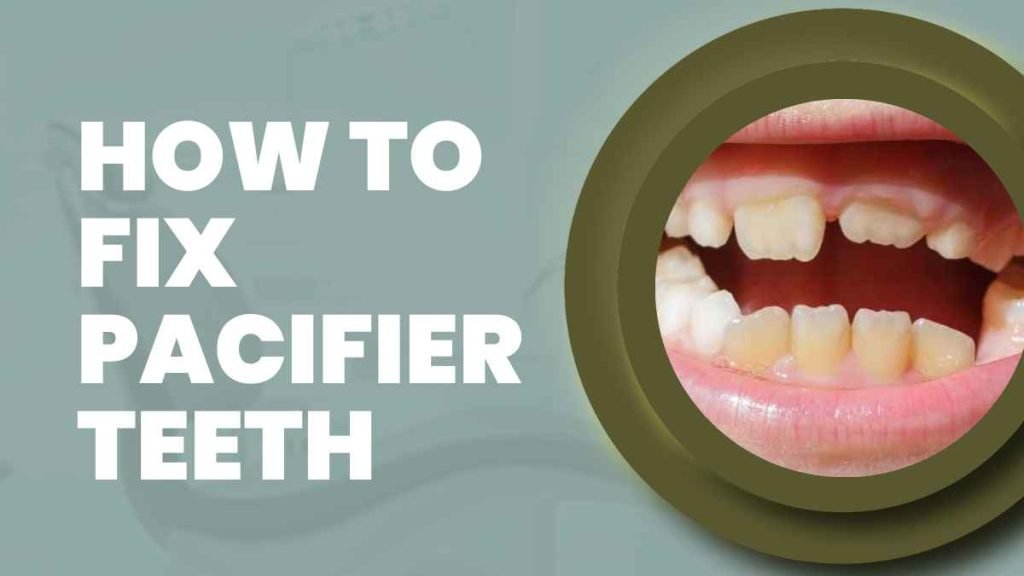How to Fix Pacifier Teeth! Pacifiers, those little soothing tools that parents love for their calming effects, can sometimes lead to dental issues in both toddlers and adults. “Pacifier teeth” is a term used to describe dental problems that arise due to prolonged pacifier use. While pacifiers can offer comfort, their extended use can cause misalignments and other dental complications. But worry not! In this guide, we will explore How to Fix Pacifier Teeth. Here we will explore what pacifier teeth are, how to fix them in toddlers and adults, common mistakes to avoid, the benefits of pacifiers, along with valuable tips, tricks, and fascinating facts.
Table of Contents
What Are Pacifier Teeth?
Pacifier teeth, medically known as malocclusions, refer to the misalignment of teeth caused by prolonged pacifier use. Children, especially toddlers, who continue using pacifiers beyond the recommended age can develop issues such as buck teeth, overbites, or misaligned jaws. Similarly, adults who excessively use pacifiers might face similar dental problems, leading to discomfort and aesthetic concerns.

How to Fix Pacifier Teeth in Toddlers?
Here you can checkout the step-by-step guide about How to Fix Pacifier Teeth in Toddlers:
Total Time: 8 minutes
Early Intervention is Key
Addressing pacifier teeth in toddlers is crucial. Consulting a pediatric dentist early on can help assess the severity of the issue and recommend appropriate interventions.
Implement Pacifier Weaning Techniques
Gradual weaning from pacifiers can prevent dental problems. Implement techniques like reducing pacifier use during daytime or offering alternative comfort items to ease the transition.
Encourage Proper Oral Habits
Promote healthy oral habits such as regular brushing, flossing, and dental check-ups. These habits contribute significantly to preventing and correcting pacifier teeth.
How to Fix Pacifier Teeth in Adults
Orthodontic Treatments
Adults with pacifier teeth issues can benefit from orthodontic treatments such as braces, aligners, or retainers. These options help in aligning teeth and correcting misalignments effectively.
Dental Implants or Bridges
In severe cases where pacifier teeth have led to tooth loss, dental implants or bridges can restore the natural appearance of the teeth, enhancing both functionality and aesthetics.
Jaw Surgery
For complex cases involving misaligned jaws due to pacifier teeth, oral surgery might be necessary. Oral surgeons can realign jaws, ensuring proper function and aesthetics.
Common Mistakes to Avoid
Prolonged Pacifier Use
Avoid letting toddlers use pacifiers for an extended period. Limit pacifier use, especially during daytime, and gradually phase it out as the child grows older.
Ignoring Dental Check-ups
Regular dental check-ups are essential. Ignoring them can lead to undetected issues, making it harder to correct pacifier teeth problems in the future.
Overlooking Oral Hygiene
Maintain excellent oral hygiene. Ignoring regular brushing and flossing can exacerbate dental issues, including those related to pacifier teeth.
What Are the Benefits of Pacifiers?
Pacifiers, when used responsibly, offer several benefits:
Soothing Effect: Pacifiers provide comfort and can help infants and toddlers self-soothe, promoting better sleep and relaxation.
Pain Relief: Pacifiers can help alleviate discomfort during teething, making it easier for infants to cope with the pain associated with new teeth.
Reducing SIDS Risk: Studies suggest that pacifier use during sleep can reduce the risk of sudden infant death syndrome (SIDS), providing an additional layer of safety for infants.
Tips and Tricks
Choose the Right Pacifier: Opt for orthodontic pacifiers designed to support proper oral development, reducing the risk of pacifier teeth issues.
Monitor Pacifier Use: Supervise pacifier use, ensuring it is limited to specific times and not a constant habit that continues into toddlerhood.
Encourage Self-Soothing Alternatives: Introduce other soothing methods like soft toys or gentle rocking to help infants and toddlers learn different ways to comfort themselves without relying solely on pacifiers.
Facts About Pacifier Teeth
- Pacifier teeth issues are preventable: With proper care and timely intervention, most pacifier teeth problems can be corrected or prevented.
- Pacifier teeth can affect speech development: Misaligned teeth can impact speech patterns, making early intervention essential for proper language development.
- Pacifier teeth are reversible with the right treatment: Many dental issues arising from pacifier use can be corrected with orthodontic treatments and proper dental care.
Conclusion
In conclusion of How to Fix Pacifier Teeth, pacifiers play a role, but their prolonged use should be approached with caution. Understanding the potential issues and addressing them promptly can ensure that pacifiers serve their purpose without causing dental complications. By choosing the right pacifiers, monitoring their use, and promoting healthy oral habits, parents can navigate the pacifier journey successfully, promoting not just comfort, but also the overall oral health of their children. Here you can checkout that How to Whiten Teeth with Braces.
FAQs About How to Fix Pacifier Teeth
Can pacifier teeth issues be completely avoided with proper usage?
While proper usage can significantly reduce the risk, genetic factors and individual differences can still contribute to pacifier teeth problems. Regular dental check-ups are crucial for early detection and intervention.
At what age should pacifier use be discontinued?
Most pediatric dentists recommend phasing out pacifier use by age 2 to prevent dental issues. However, every child is different; consulting a dentist can provide personalized guidance.
Are there specific pacifiers that are better for oral health?
Orthodontic pacifiers, designed to support natural oral development, are often recommended. These pacifiers help minimize the risk of dental problems.
How can parents help toddlers transition away from pacifiers?
Gradual weaning methods, positive reinforcement, and offering alternative comfort items like soft toys or blankets can ease the transition away from pacifiers.
Can pacifier teeth issues affect adults who used pacifiers as children?
Yes, adults who had pacifier teeth issues as children might still experience dental problems. Orthodontic treatments can help correct these issues in adulthood.
Are there long-term health consequences associated with pacifier teeth problems?
Untreated pacifier teeth issues can lead to various problems, including difficulty in chewing, speech problems, and temporomandibular joint disorders (TMJ). Early intervention is essential to prevent long-term consequences.
How can parents encourage oral hygiene in toddlers and young children?
Parents can make oral hygiene fun by using colorful toothbrushes and toothpaste, supervising brushing sessions, and setting a positive example by maintaining their own oral hygiene habits.


